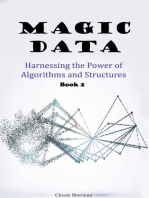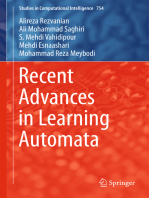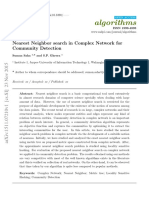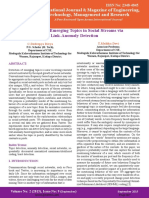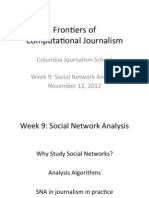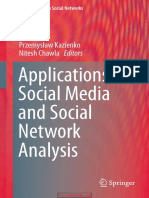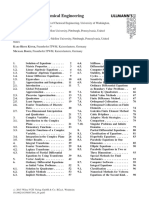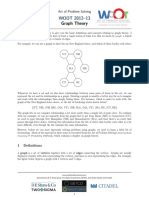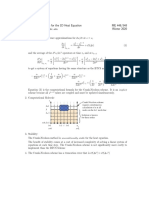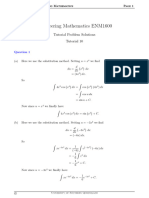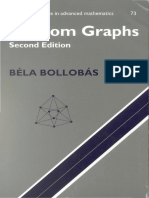Professional Documents
Culture Documents
Unpacking The Black Box An Exploration of The Algorithms Driving Social Media Networks-A Review
Original Title
Copyright
Available Formats
Share this document
Did you find this document useful?
Is this content inappropriate?
Report this DocumentCopyright:
Available Formats
Unpacking The Black Box An Exploration of The Algorithms Driving Social Media Networks-A Review
Copyright:
Available Formats
Volume 8, Issue 5, May – 2023 International Journal of Innovative Science and Research Technology
ISSN No:-2456-2165
Unpacking the Black Box: An Exploration of the
Algorithms Driving
Social Media Networks-A Review
Amey Thorat Amulya Kura
Department of Computer Engineering Department of Computer Engineering
Vidyalankar Institute of Technology Vidyalankar Institute of Technology
Ansika Jaiswal Sapana Survase
Department of Computer Engineering Department of Computer Engineering
Vidyalankar Institute of Technology Vidyalankar Institute of Technology
Amit Aylani
Prof., Department of Computer Engineering
Vidyalankar Institute of Technology
Abstract:- Social media algorithms are used for finding professionals in your field, you may utilize social media to
detailed information in large unstructured data by advance your professional network and increase your
relevant keywords used by users. There are different expertise in a certain subject. Social media gives your
algorithms used for social media from a searching point business the opportunity to interact with customers, get their
of view. One of the algorithms is the "Probability of opinion, and build brand recognition.
Node's Degree" algorithm, which is based on the concept
of breadth-first search, random walk, and the highest Online social networks (OSNs) have recently gained
degree seeking algorithm. The algorithm involves considerable attention. For example, Twitter had over 300
selecting a source node and a target node, and then million monthly active users in 2018. There are many studies
traversing the nodes in the network to find the target that have analyzed a particular OSN as a graph with nodes of
node. The algorithm checks if the target node is a users and edges of relationships among users.
neighbor of the current node and, if not, transmits a
query message to other nodes based on their probability In this paper, we will discuss the findings of various
of being relevant to the search. Nodes with higher degrees researchers on different algorithms related to complex
are more likely to be searched, making the algorithm networks. The first paper by GU Yiran and ZHAO Wenwen
beneficial to nodes with higher degrees. In addition to introduces the concept of the Probability of Node's Degree
this, there are other algorithms such as FP-FOREST, algorithm that is based on breadth-first search, random walk,
DSTree, UPTree algorithm, and KC-LA, which are used and the highest-degree seeking algorithm. The second paper
for finding frequent patterns, maintaining and mining discusses the development of a compact data structure named
frequent item sets, and finding K-Clique in complex FP-FOREST that enhances the performance of an existing
social networks. These algorithms are useful in data- algorithm called INSTANT for frequent pattern mining in
driven decision-making and in gaining insights into social social media streams. The third paper by Mohammad Mehdi
media analytics. Daliri Khomami et al. proposes a distributed learning
automata-based algorithm called KC-LA for finding K-
Keywords:- Social Media Algorithm, Social Media Analytics, Clique in complex social networks. This paper covers various
Complex Social Network, Social Media, K-Clique, Learning algorithms proposed for solving maximal clique finding,
Automation, Betweenness Centrality, Random Walk. which is an NP-hard problem, with practical applications in
community detection in social networks. The fourth paper
I. INTRODUCTION discusses the estimation of top nodes which has highest
betweenness centrality which has a shortest path pass
Social Media has become an integral part of our daily through the vertices. In the following sections, we will
lives, allowing people to connect, share, and exchange discuss each paper and highlight their contributions to the
information and ideas in virtual communities and networks. field of complex networks.
Social media may help us connect with friends and
family, learn about and pursue new hobbies, and have fun
from a personal viewpoint. By engaging with other
IJISRT23MAY444 www.ijisrt.com 819
Volume 8, Issue 5, May – 2023 International Journal of Innovative Science and Research Technology
ISSN No:-2456-2165
II. LITERATURE SURVEY unordered data, these fundamental data structures are helpful.
A hash table, for instance, offers instant access to data that is
A. Probability Of Node’s Degree On Complex Networks indexed by any key value, which could be a dictionary, a
In this Paper, author GU Yiran, ZHAO Wenwen number (such as a memory address for cached memory), or a
proposed the social media’s search algorithm “Probability of URL. Graphs are used to represent relationships between
Node’s Degree” which is based on the concept of breadth objects, and this course covers a variety of graph
first search, random walk, highest degree seeking algorithm. representational data structures and graph traversal
algorithms, such as determining the shortest path between
Before going on an improved algorithm of probability two nodes. This course will also address disjoint sets, another
of node’s degree first we will see the based algorithm of idea on which these graph algorithms will depend.data
concept. Breadth First Search (BFS) begins as a level order structure and associated algorithms.
traversal. Basically, in this algorithm, we can find the path
between two people in level order. Random Walk algorithm C. Finding K-Clique In Complex Social Networks
is used for extracting information from the ensemble of paths The selected paper titled “Distributed Learning
between persons in a graph. Process of searching for the Automata-based Algorithm for Finding K-Clique in Complex
highest-degree neighbor in DS in each node is aware of the Social Network” authored by Mohammad Mehdi Daliri
information about its neighbors. However, it also somewhat Khomami et al. Proposes a new algorithm that utilizes
lessens the search process's query message flow, which can distributed LAs to solve k-Clique called(KC-LA)in social
help prevent network congestion. networks.
Now, based on the above concept, the probability of a The authors discuss the problem of maximal clique
node's degree algorithm is explained, which is given above: finding in graphs, which involves finding a subset of nodes in
Each node knows the degree of its use neighbors, as shown a graph where each node is connected pairwise. The
by the image of the search by degree sequence, and searches maximum clique refers to the clique with the largest number
for the neighbor with the highest degree at each step. The of nodes. This problem is NP-hard, and various algorithms
neighbor with the second-highest degree will be picked to have been proposed to solve it, including k-clique
broadcast a query message if the neighbor with the highest algorithms, which involve finding cliques with a fixed size k.
degree has already been visited. The search technique can Many of these algorithms fall into one of three categories:
thus get the best possible results when used on complex deterministic, heuristic, and approximation. Maximal clique
networks. finding has practical applications in fields such as
community detection in social networks. Some researchers
Algorithm of probability of node's degree search (PDS) have attempted to utilize the concept of cliques for
works as follows: community detection, and various algorithms have been
This algorithm involves selecting a source node and a developed for this purpose. Additionally, the authors mention
target node, and then traversing the nodes in the network to LA-based algorithms that have been successful in solving
find the target node. The algorithm checks if the target node graph problems such as positive influence dominating set,
is a neighbor of the current node and if not, transmits a query independent set, vertex cover, and community detection.
message to other nodes based on their probability of being
relevant to the search. Nodes with higher degrees are more Now based on the above concept, a learning automaton
likely to be searched, making the algorithm beneficial to is a type of learning model that learns to choose the best
nodes with higher degrees. Nodes can be visited more than action from a set of actions in a random environment by
once, edges can be visited only once. The search continues receiving feedback in the form of rewards or penalties. It
until the target node is found or all the nodes have been updates its probability vector for selecting actions based on
visited. whether the feedback is favorable or unfavorable. A DLA is
a network of LA that cooperates to solve a particular
B. Finding Frequent Patterns In Social Media Streams problem. In this work, just a LA is deactivated at a ume. The
A cutting-edge algorithm called INSTANT is being number of actions performed by automata is equal to the
improved with the help of a small data structure called FP- number of LAS Connected to it [3].
FOREST, which demonstrates how to compress itemsets and
count supports efficiently. The algorithm performs better in KC-LA based for k-Clique -
terms of memory use and execution time, according to the The KC-LA algorithm finds a k-clique in a social graph
results. By utilising its appealing qualities, a novel tree by using a network of learning automata. Each automaton is
structure known as DSTree (Data Stream Tree) gathers assigned to a vertex and chooses actions corresponding to the
significant data from streams and can be readily maintained edges connected to the vertex. The algorithm selects an
and mined for frequent itemsets as well as numerous other automaton, activates it, and adds it to the k-clique set. The
patterns such restricted automaton selects an action, and the algorithm checks
whether it can be added to the k-clique set. The process
UPTree algorithm - continues until all automata are disabled. The algorithm
Hash tables, disjoint sets, and graphs can all be evaluates the cardinality of the k-clique set and rewards or
implemented using the data structures and algorithms penalizes the selected action based on whether it increases or
covered in the Unordered Data Structures course. For decreases the size of the k-clique set. The algorithm also
IJISRT23MAY444 www.ijisrt.com 820
Volume 8, Issue 5, May – 2023 International Journal of Innovative Science and Research Technology
ISSN No:-2456-2165
modifies the probability of selecting actions based on the method which has an overall high collection ratio. In the
degree of nodes to improve the selection process. second stage the top-k nodes are estimated from a gram
which has highest betweenness centrality. In this paper the
D. Estimation of Top-K Betweenness Centrality Nodes author proposed a new crawling based algorithm which first
In the paper “Estimating Top-k Betweenness Centrality estimates the ego betweenness centrality by random walk and
Nodes in Online Social Networks”, author proposed a new then estimates the top-k betweenness centrality.
crawling-based algorithm to estimate the top-k nodes in
online social networks which has the highest betweenness The betweenness centrality is the sum of the ratio of
centrality. Privacy and security concerns prevent obtaining shortest paths between two nodes which pass through a node
complete information in Online social networks hence in the graph. The users or nodes which have high
Crawling based algorithm is used which considers limitation betweenness centrality in online social networks are the main
of request. This algorithm works in two stages: the first is a key for the spread of information. Since these nodes have
sampling method in which edges or nodes are sampled from high betweenness centrality, hence they are present on many
a graph. They describe that they should choose a sampling of the shortest paths in the graph.
III. COMPARISON
Probability of Node’s Finding Frequent Finding K- Clique
Estimation of Top-k
Degree Patterns between ness centrality
TOPIC nodes
WHY IS IT NEED ED? To Send Message using Mining associations , Community detection, Finding the nodes which
highest degree node correlations, relationships solving graph problems plays bridge role in
among data network
LIMITATIONS Only works for Mining frequent patterns Identifying largest Ignores path and hops for
undirected graph in large dataset subgraph of size k longer than shorter path
Table 1 Comparison
IV. CONCLUSION Network”2020 11th International Conference on
Information and Knowledge Technology(IKT)
The improvements show an effect on search cost and [4]. E.A. Akkoyunlu,”The enumeration of maximal
the efficiency of the search. To extract frequent patterns, FP- cliques of large graphs, ”SIAM Journal on Computing
tree algorithms combined with LRU structure, UPTree is ,vol. 2,no. 1,pp.1-6,1973
exploited. It modifies the probability of selecting actions [5]. M.Regneri,”Finding all cliques of an undirected
based on degree of nodes to improve the selection process. graph,”2007
Top-k betweenness centrality nodes estimated to flow the [6]. Peter Mika. “Ontologies are us: A unified model of
information all over the network. social networks and semantics”, In Proc.14th
International Semantic Web Conference, 2005
V. FUTURE SCOPE [7]. Matsuo Y, Hasida K, Tomobe H, Ishizuka M.
“Mining social network of conference participants
In this paper, we discussed the algorithms which are from the web”, IEEE/WIC International Conference,
mainly based on undirected graphs for finding required 2003
information which can be found by one side only. So we can [8]. Kazuki Nakajima, Kenta Iwasaki, Toshiki
upgrade the algorithm to use it in directed graphs and can Matsumura, Kazuyuki Shudo, “Estimating Top-k
suggest searching from both ends. Betweenness Centrality Nodes in Online Social
Networks”, International Conference on. IEEE,2018.
REFERENCES [9]. L. C. Freeman, “A set of measures of centrality based
on betweenness,” Sociometry, vol. 40, no. 1, pp. 35–
[1]. GU Yiran, ZHAO Wenwen,"Improved Search 41, 1977
Algorithm Based on Probability of Node's degree on [10]. T. Matsumura, K. Iwasaki, and K. Shudo, “Average
Complex Networks" in 2012 Third International path length estimation of social networks by random
Conference on Digital Manufacturing & Automation walk,” in Big Data and Smart Computing (BigComp),
[2]. Suwook Ha, Yong Mi Lee, Kwang Woo Nam, and 2018 IEEE International Conference on. IEEE, 2018,
Keun Ho Ryu,”An Algorithm for Finding Frequent pp. 611–614
Patterns in Social Media Stream”, in International [11]. B. Goethals, M. J. Zaki, Workshop Report on
Conference on ICT Convergence (ICTC) on 14-16 Workshop on Frequent Itemset Mining
October 2013 Implementations (FIMI), ACM SIGKDD
[3]. Mohamad Mehdi Daliri Khomami,Alireza Rezvanian, Explorations Newsletter - Special issue on learning
Ali Mohannad Saghiri, Mohammad Reza Meybodi, from imbalanced datasets, vol. 6(1), June 2004.
“Distributed Learning Automata-based Algorithm
for Finding K- Clique in Complex Social
IJISRT23MAY444 www.ijisrt.com 821
You might also like
- Wireless Network Simulation: A Guide using Ad Hoc Networks and the ns-3 SimulatorFrom EverandWireless Network Simulation: A Guide using Ad Hoc Networks and the ns-3 SimulatorNo ratings yet
- Network SamplingDocument25 pagesNetwork Samplingarienahussin02No ratings yet
- Social Network Analysis and Sentiment Detection Using PythonDocument6 pagesSocial Network Analysis and Sentiment Detection Using PythonDedy HariyadiNo ratings yet
- AssignmentDocument2 pagesAssignmentBe a king not godNo ratings yet
- Magic Data: Part 2 - Harnessing the Power of Algorithms and StructuresFrom EverandMagic Data: Part 2 - Harnessing the Power of Algorithms and StructuresNo ratings yet
- Book SN (Autosaved1) 2013Document313 pagesBook SN (Autosaved1) 2013محمد عسكرNo ratings yet
- Clustering Methods For Big Data Analytics Techniques, Toolboxes and ApplicationsDocument192 pagesClustering Methods For Big Data Analytics Techniques, Toolboxes and Applicationseda cevikNo ratings yet
- Machine Learning Guide: A Comprehensive IntroductionDocument13 pagesMachine Learning Guide: A Comprehensive IntroductionNischay GowdaNo ratings yet
- Social Network Analysis - ANG6930 - Sept11Document7 pagesSocial Network Analysis - ANG6930 - Sept11thomasNo ratings yet
- An Improved K-Means Cluster Algorithm Using Map Reduce Techniques To Mining of Inter and Intra Cluster Datain Big Data AnalyticsDocument12 pagesAn Improved K-Means Cluster Algorithm Using Map Reduce Techniques To Mining of Inter and Intra Cluster Datain Big Data AnalyticsjefferyleclercNo ratings yet
- Artificial Neural Network Literature ReviewDocument5 pagesArtificial Neural Network Literature Reviewcmppcmwgf100% (1)
- 5 2008 SNAKDD2008-WR SNAKDD 2008 - Social Network Mining and Analysis Post-Workshop ReportDocument4 pages5 2008 SNAKDD2008-WR SNAKDD 2008 - Social Network Mining and Analysis Post-Workshop Reportdonganh89No ratings yet
- Entropy: Research On Community Detection in Complex Networks Based On Internode AttractionDocument16 pagesEntropy: Research On Community Detection in Complex Networks Based On Internode AttractionAdrian Maulana MuhammadNo ratings yet
- Ego-Net Community Mining Applied To Friend SuggestionDocument12 pagesEgo-Net Community Mining Applied To Friend SuggestionbharathNo ratings yet
- Finding Experts in Community Based Question-Answering Services-IJAERDV04I0115724Document6 pagesFinding Experts in Community Based Question-Answering Services-IJAERDV04I0115724Editor IJAERDNo ratings yet
- A Review: Machine Learning Approach and Deep Learning Approach For Fake News DetectionDocument5 pagesA Review: Machine Learning Approach and Deep Learning Approach For Fake News DetectionWARSE JournalsNo ratings yet
- Research Paper On Algorithm AnalysisDocument8 pagesResearch Paper On Algorithm Analysisfysxfjac100% (1)
- Research Paper On Data Mining AlgorithmsDocument6 pagesResearch Paper On Data Mining Algorithmswihefik1t0j3100% (1)
- An Analysis of Clustering Algorithms For Big DataDocument5 pagesAn Analysis of Clustering Algorithms For Big DataInternational Journal of Innovative Science and Research TechnologyNo ratings yet
- AM08 Gruzd Hay ICTADocument5 pagesAM08 Gruzd Hay ICTAkcwbsgNo ratings yet
- Python For Graph and Network AnalysisDocument214 pagesPython For Graph and Network AnalysisQuebec Immigration DocNo ratings yet
- The Role of Information Diffusion in The Evolution of Social NetworksDocument9 pagesThe Role of Information Diffusion in The Evolution of Social NetworksBenaoNo ratings yet
- Social Network Analysis Literature ReviewDocument6 pagesSocial Network Analysis Literature Reviewafmzjbxmbfpoox100% (1)
- SMA Exp 2Document4 pagesSMA Exp 2pameluftNo ratings yet
- Anomaly Detection in NetworksDocument19 pagesAnomaly Detection in NetworksÅlex AbbeyNo ratings yet
- Neural Networks in Data MiningDocument6 pagesNeural Networks in Data MiningTj GillNo ratings yet
- Discovering Emerging Topics in Social Streams Via Link-Anomaly DetectionDocument5 pagesDiscovering Emerging Topics in Social Streams Via Link-Anomaly DetectionPraveena Suresh BabuNo ratings yet
- Paper 74Document10 pagesPaper 74Vikas KhannaNo ratings yet
- A Multi-Objective Bat Algorithm For Community Detection On Dynamic Social NetworksDocument18 pagesA Multi-Objective Bat Algorithm For Community Detection On Dynamic Social NetworksDebapriya MitraNo ratings yet
- (Lecture Notes in Social Networks) Fazli Can, Tansel Özyer, Faruk Polat (Eds.) - State of The Art Applications of Social Network Analysis-Springer International Publishing (2014)Document375 pages(Lecture Notes in Social Networks) Fazli Can, Tansel Özyer, Faruk Polat (Eds.) - State of The Art Applications of Social Network Analysis-Springer International Publishing (2014)luanamdonascimentoNo ratings yet
- Methods For Extracting Relational Data From Unstructured Texts Prior To Network Visualization in Humanities ResearchDocument8 pagesMethods For Extracting Relational Data From Unstructured Texts Prior To Network Visualization in Humanities ResearchmaverileNo ratings yet
- Scalable Learning of Collective Behaviour: AbstractDocument4 pagesScalable Learning of Collective Behaviour: Abstractanon_679312409No ratings yet
- Conference LaTeX Template 10 17 19Document4 pagesConference LaTeX Template 10 17 19Chaitali NarayaneNo ratings yet
- Inductive Learning Algorithms For Coplex Systems Modeling PDFDocument373 pagesInductive Learning Algorithms For Coplex Systems Modeling PDFggropNo ratings yet
- Unsupervised LearningDocument3 pagesUnsupervised LearningAjayChandrakarNo ratings yet
- 07516129Document6 pages07516129Govind UpadhyayNo ratings yet
- Frontiers of Computational Journalism - Columbia Journalism School Fall 2012 - Week 9: Social Network AnalysisDocument28 pagesFrontiers of Computational Journalism - Columbia Journalism School Fall 2012 - Week 9: Social Network AnalysisJonathan Stray100% (1)
- Topic Categorization Based On User Behaviour in Random Social Networks Using Firefly AlgorithmDocument5 pagesTopic Categorization Based On User Behaviour in Random Social Networks Using Firefly AlgorithmBONFRINGNo ratings yet
- Applications of Social Media and Social Network Analysis - Lecture Notes in Social Networks PDFDocument247 pagesApplications of Social Media and Social Network Analysis - Lecture Notes in Social Networks PDFrwrewrwt100% (1)
- Seminar On Machine Learning and AiDocument15 pagesSeminar On Machine Learning and AiOlatunde LekanNo ratings yet
- Increasing The Investment's Opportunities in Kingdom of Saudi Arabia by Studying and Analyzing The Social Media DataDocument16 pagesIncreasing The Investment's Opportunities in Kingdom of Saudi Arabia by Studying and Analyzing The Social Media DataAnonymous Gl4IRRjzNNo ratings yet
- Increasing The Investment's Opportunities in Kingdom of Saudi Arabia by Studying and Analyzing The Social Media DataDocument16 pagesIncreasing The Investment's Opportunities in Kingdom of Saudi Arabia by Studying and Analyzing The Social Media DataAnonymous Gl4IRRjzNNo ratings yet
- A Cohesion Based Friend Recommendation SystemDocument16 pagesA Cohesion Based Friend Recommendation SystemCS & ITNo ratings yet
- Trends in Social Network Analysis: Rokia Missaoui Talel Abdessalem Matthieu Latapy EditorsDocument264 pagesTrends in Social Network Analysis: Rokia Missaoui Talel Abdessalem Matthieu Latapy EditorsTijanaNo ratings yet
- The Spammer Detection and Fake User Identification On Social NetworksDocument8 pagesThe Spammer Detection and Fake User Identification On Social NetworksIJRASETPublicationsNo ratings yet
- Neural Networks: A Practical Guide for Understanding and Programming Neural Networks and Useful Insights for Inspiring ReinventionFrom EverandNeural Networks: A Practical Guide for Understanding and Programming Neural Networks and Useful Insights for Inspiring ReinventionRating: 4 out of 5 stars4/5 (8)
- A Survey of Graph Neural Networks For Recommender Systems - Challenges, Methods, and DirectionsDocument51 pagesA Survey of Graph Neural Networks For Recommender Systems - Challenges, Methods, and DirectionsShivin DiwakarNo ratings yet
- Data Mining and Analysis of Online Social NetworksDocument4 pagesData Mining and Analysis of Online Social NetworksijcnesNo ratings yet
- Data Mining Based Soft Computing Methods For Web IntelligenceDocument7 pagesData Mining Based Soft Computing Methods For Web IntelligenceInternational Journal of Application or Innovation in Engineering & ManagementNo ratings yet
- Hybrid Neuro-Fuzzy Classification Algorithm For Social NetworkDocument4 pagesHybrid Neuro-Fuzzy Classification Algorithm For Social NetworkdivyaNo ratings yet
- Neural Networks Seminar ReportDocument25 pagesNeural Networks Seminar ReportAditya Agarwal0% (1)
- SLR Sample 8Document6 pagesSLR Sample 8Hassan IshaqNo ratings yet
- Journal Tiis 16-12 942300739Document21 pagesJournal Tiis 16-12 942300739VASUDEVAN N (RC2113003011006)No ratings yet
- Presented By: Kavya.MDocument13 pagesPresented By: Kavya.MTariq GoldiNo ratings yet
- Data Mining Framework For Network Intrusion Detection Using Efficient TechniquesDocument6 pagesData Mining Framework For Network Intrusion Detection Using Efficient TechniquesPoonam KilaniyaNo ratings yet
- Commercial Usage Using Big DataDocument4 pagesCommercial Usage Using Big Dataপ্রজ্ঞা লাবনীNo ratings yet
- An Analysis on Mental Health Issues among IndividualsDocument6 pagesAn Analysis on Mental Health Issues among IndividualsInternational Journal of Innovative Science and Research TechnologyNo ratings yet
- Harnessing Open Innovation for Translating Global Languages into Indian LanuagesDocument7 pagesHarnessing Open Innovation for Translating Global Languages into Indian LanuagesInternational Journal of Innovative Science and Research TechnologyNo ratings yet
- Diabetic Retinopathy Stage Detection Using CNN and Inception V3Document9 pagesDiabetic Retinopathy Stage Detection Using CNN and Inception V3International Journal of Innovative Science and Research TechnologyNo ratings yet
- Investigating Factors Influencing Employee Absenteeism: A Case Study of Secondary Schools in MuscatDocument16 pagesInvestigating Factors Influencing Employee Absenteeism: A Case Study of Secondary Schools in MuscatInternational Journal of Innovative Science and Research TechnologyNo ratings yet
- Exploring the Molecular Docking Interactions between the Polyherbal Formulation Ibadhychooranam and Human Aldose Reductase Enzyme as a Novel Approach for Investigating its Potential Efficacy in Management of CataractDocument7 pagesExploring the Molecular Docking Interactions between the Polyherbal Formulation Ibadhychooranam and Human Aldose Reductase Enzyme as a Novel Approach for Investigating its Potential Efficacy in Management of CataractInternational Journal of Innovative Science and Research TechnologyNo ratings yet
- The Making of Object Recognition Eyeglasses for the Visually Impaired using Image AIDocument6 pagesThe Making of Object Recognition Eyeglasses for the Visually Impaired using Image AIInternational Journal of Innovative Science and Research TechnologyNo ratings yet
- The Relationship between Teacher Reflective Practice and Students Engagement in the Public Elementary SchoolDocument31 pagesThe Relationship between Teacher Reflective Practice and Students Engagement in the Public Elementary SchoolInternational Journal of Innovative Science and Research TechnologyNo ratings yet
- Dense Wavelength Division Multiplexing (DWDM) in IT Networks: A Leap Beyond Synchronous Digital Hierarchy (SDH)Document2 pagesDense Wavelength Division Multiplexing (DWDM) in IT Networks: A Leap Beyond Synchronous Digital Hierarchy (SDH)International Journal of Innovative Science and Research TechnologyNo ratings yet
- Comparatively Design and Analyze Elevated Rectangular Water Reservoir with and without Bracing for Different Stagging HeightDocument4 pagesComparatively Design and Analyze Elevated Rectangular Water Reservoir with and without Bracing for Different Stagging HeightInternational Journal of Innovative Science and Research TechnologyNo ratings yet
- The Impact of Digital Marketing Dimensions on Customer SatisfactionDocument6 pagesThe Impact of Digital Marketing Dimensions on Customer SatisfactionInternational Journal of Innovative Science and Research TechnologyNo ratings yet
- Electro-Optics Properties of Intact Cocoa Beans based on Near Infrared TechnologyDocument7 pagesElectro-Optics Properties of Intact Cocoa Beans based on Near Infrared TechnologyInternational Journal of Innovative Science and Research TechnologyNo ratings yet
- Formulation and Evaluation of Poly Herbal Body ScrubDocument6 pagesFormulation and Evaluation of Poly Herbal Body ScrubInternational Journal of Innovative Science and Research TechnologyNo ratings yet
- Advancing Healthcare Predictions: Harnessing Machine Learning for Accurate Health Index PrognosisDocument8 pagesAdvancing Healthcare Predictions: Harnessing Machine Learning for Accurate Health Index PrognosisInternational Journal of Innovative Science and Research TechnologyNo ratings yet
- The Utilization of Date Palm (Phoenix dactylifera) Leaf Fiber as a Main Component in Making an Improvised Water FilterDocument11 pagesThe Utilization of Date Palm (Phoenix dactylifera) Leaf Fiber as a Main Component in Making an Improvised Water FilterInternational Journal of Innovative Science and Research TechnologyNo ratings yet
- Cyberbullying: Legal and Ethical Implications, Challenges and Opportunities for Policy DevelopmentDocument7 pagesCyberbullying: Legal and Ethical Implications, Challenges and Opportunities for Policy DevelopmentInternational Journal of Innovative Science and Research TechnologyNo ratings yet
- Auto Encoder Driven Hybrid Pipelines for Image Deblurring using NAFNETDocument6 pagesAuto Encoder Driven Hybrid Pipelines for Image Deblurring using NAFNETInternational Journal of Innovative Science and Research TechnologyNo ratings yet
- Terracing as an Old-Style Scheme of Soil Water Preservation in Djingliya-Mandara Mountains- CameroonDocument14 pagesTerracing as an Old-Style Scheme of Soil Water Preservation in Djingliya-Mandara Mountains- CameroonInternational Journal of Innovative Science and Research TechnologyNo ratings yet
- A Survey of the Plastic Waste used in Paving BlocksDocument4 pagesA Survey of the Plastic Waste used in Paving BlocksInternational Journal of Innovative Science and Research TechnologyNo ratings yet
- Hepatic Portovenous Gas in a Young MaleDocument2 pagesHepatic Portovenous Gas in a Young MaleInternational Journal of Innovative Science and Research TechnologyNo ratings yet
- Design, Development and Evaluation of Methi-Shikakai Herbal ShampooDocument8 pagesDesign, Development and Evaluation of Methi-Shikakai Herbal ShampooInternational Journal of Innovative Science and Research Technology100% (3)
- Explorning the Role of Machine Learning in Enhancing Cloud SecurityDocument5 pagesExplorning the Role of Machine Learning in Enhancing Cloud SecurityInternational Journal of Innovative Science and Research TechnologyNo ratings yet
- A Review: Pink Eye Outbreak in IndiaDocument3 pagesA Review: Pink Eye Outbreak in IndiaInternational Journal of Innovative Science and Research TechnologyNo ratings yet
- Automatic Power Factor ControllerDocument4 pagesAutomatic Power Factor ControllerInternational Journal of Innovative Science and Research TechnologyNo ratings yet
- Review of Biomechanics in Footwear Design and Development: An Exploration of Key Concepts and InnovationsDocument5 pagesReview of Biomechanics in Footwear Design and Development: An Exploration of Key Concepts and InnovationsInternational Journal of Innovative Science and Research TechnologyNo ratings yet
- Mobile Distractions among Adolescents: Impact on Learning in the Aftermath of COVID-19 in IndiaDocument2 pagesMobile Distractions among Adolescents: Impact on Learning in the Aftermath of COVID-19 in IndiaInternational Journal of Innovative Science and Research TechnologyNo ratings yet
- Studying the Situation and Proposing Some Basic Solutions to Improve Psychological Harmony Between Managerial Staff and Students of Medical Universities in Hanoi AreaDocument5 pagesStudying the Situation and Proposing Some Basic Solutions to Improve Psychological Harmony Between Managerial Staff and Students of Medical Universities in Hanoi AreaInternational Journal of Innovative Science and Research TechnologyNo ratings yet
- Navigating Digitalization: AHP Insights for SMEs' Strategic TransformationDocument11 pagesNavigating Digitalization: AHP Insights for SMEs' Strategic TransformationInternational Journal of Innovative Science and Research Technology100% (1)
- Drug Dosage Control System Using Reinforcement LearningDocument8 pagesDrug Dosage Control System Using Reinforcement LearningInternational Journal of Innovative Science and Research TechnologyNo ratings yet
- The Effect of Time Variables as Predictors of Senior Secondary School Students' Mathematical Performance Department of Mathematics Education Freetown PolytechnicDocument7 pagesThe Effect of Time Variables as Predictors of Senior Secondary School Students' Mathematical Performance Department of Mathematics Education Freetown PolytechnicInternational Journal of Innovative Science and Research TechnologyNo ratings yet
- Formation of New Technology in Automated Highway System in Peripheral HighwayDocument6 pagesFormation of New Technology in Automated Highway System in Peripheral HighwayInternational Journal of Innovative Science and Research TechnologyNo ratings yet
- Numerical Methods IIDocument22 pagesNumerical Methods IIMuktaNo ratings yet
- DIFFERENTIATION RULES AND INTEGRALS REFERENCEDocument2 pagesDIFFERENTIATION RULES AND INTEGRALS REFERENCEClarence PascualNo ratings yet
- Co-Roman Domination in GraphsDocument10 pagesCo-Roman Domination in GraphsMartin ManriqueNo ratings yet
- Calculus PDFDocument161 pagesCalculus PDFLe Nguyen Quang Dang Khoa0% (1)
- Golden Section SearchDocument6 pagesGolden Section Searchsiti_umrahNo ratings yet
- Recurrenec Relation CHAPTER 3Document14 pagesRecurrenec Relation CHAPTER 3Babal YepaNo ratings yet
- Basic Integration Formula SheetDocument1 pageBasic Integration Formula SheetbihanichandreshNo ratings yet
- 3.2 Properties of DeterminantsDocument15 pages3.2 Properties of Determinantssanju_17No ratings yet
- Iso-Parametric Formulation: OutlinesDocument38 pagesIso-Parametric Formulation: OutlinesgvnagamaniNo ratings yet
- 8 Advanced Mathematics PDFDocument5 pages8 Advanced Mathematics PDFHanna MarineNo ratings yet
- Graph Theory BasicsDocument14 pagesGraph Theory Basicssayan paul100% (1)
- CN NutshellDocument3 pagesCN NutshellMuhammad SaqlainNo ratings yet
- Integration by Substitution: SolutionDocument3 pagesIntegration by Substitution: SolutionVape DrugNo ratings yet
- Inner Automorphism Group of D4 is Z2 x Z2Document5 pagesInner Automorphism Group of D4 is Z2 x Z2free_progNo ratings yet
- MCV4U - Unit 2 - Version ADocument53 pagesMCV4U - Unit 2 - Version AhayatNo ratings yet
- Text Book References (Stewart)Document3 pagesText Book References (Stewart)ANo ratings yet
- Surv092 EndmatterDocument77 pagesSurv092 EndmatterDEEPU GNo ratings yet
- 2223 Level LS Mathematics Algebra 4 Course Questions SolutionsDocument94 pages2223 Level LS Mathematics Algebra 4 Course Questions SolutionsFeras SrourNo ratings yet
- Calculate Integrals Using SubstitutionDocument9 pagesCalculate Integrals Using SubstitutionTony111No ratings yet
- 13.472J/1.128J/2.158J/16.940J Computational Geometry: N. M. PatrikalakisDocument23 pages13.472J/1.128J/2.158J/16.940J Computational Geometry: N. M. PatrikalakisramkumarNo ratings yet
- Algorithm Design Methods: Greedy Method. Divide and Conquer. Dynamic Programming. Backtracking. Branch and BoundDocument24 pagesAlgorithm Design Methods: Greedy Method. Divide and Conquer. Dynamic Programming. Backtracking. Branch and BoundKrzysztof TNo ratings yet
- ENM1600_Tutorial10_SolnDocument34 pagesENM1600_Tutorial10_SolnPamithaNo ratings yet
- Algebra and Trigonometry 5th Edition Blitzer Test BankDocument34 pagesAlgebra and Trigonometry 5th Edition Blitzer Test Banklilykeva56r100% (29)
- (Béla Bollobás) Random Graphs, Second Edition (C (BookFi) PDFDocument517 pages(Béla Bollobás) Random Graphs, Second Edition (C (BookFi) PDFcharlyshaka1100% (1)
- FunctionsDocument15 pagesFunctionsyankhochataika04No ratings yet
- Matrices and DeterminantsDocument33 pagesMatrices and Determinantsazimsikder01757No ratings yet
- Subspace Definition and PropertiesDocument29 pagesSubspace Definition and Propertiesjuasjuas777No ratings yet




